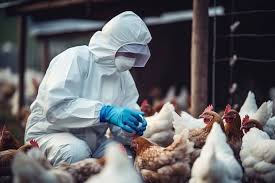An outbreak of H5N1 avian influenza is causing significant concern, killing large numbers of wild birds in Massachusetts and sickening dairy cows in at least 16 U.S. states. Meanwhile, a new strain, H5N9, has emerged in California, further raising alarms among experts. As these viruses continue to spread among animals, the potential for them to evolve into a human threat is under close scrutiny.
Currently, the risk to human health remains low, even with the new strain. However, the situation is far from being completely under control.
The Risk to Humans: Low But Monitored
Jeffery A. Goad, president of the National Foundation for Infectious Diseases, emphasizes that while the avian flu virus has led to 67 confirmed human cases, all of them have been traced back to animal sources, and there has been no evidence of human-to-human transmission. “If that were to occur, then we might be facing another pandemic, as almost no one would be immune,” he warns. Goad adds that the virus would need to undergo significant genetic changes before it could be transmitted between humans, something that has not yet happened.
This news comes as health professionals are still recovering from the aftermath of the COVID-19 pandemic. The prospect of another viral outbreak is daunting, but experts highlight that unlike COVID-19, which was an entirely new virus, the H5N1 virus has been known for some time. There are already vaccines and treatments available, with more in development, to combat this known virus.
A Familiar Foe, but Still Unpredictable
Brian Labus, an assistant professor of epidemiology and statistics at the University of Nevada Las Vegas, points out that while the virus seems to be following its typical pattern, mutations could still occur that might lead to unforeseen challenges. “If it continues on the same path, human cases will remain limited to those with occupational exposure,” Labus explains. “However, if the virus mutates, it could result in new problems, and that’s what we have to prepare for.”
Health officials are particularly focused on ensuring that any potential new strain would not catch the global population off guard, as it did with COVID-19. While the risk remains low, ongoing monitoring is essential to prevent an outbreak among humans.
Stockpiling Vaccines: Preparing for the Worst
The U.S. government has made significant preparations to tackle an H5N1 outbreak, should it become a larger threat to human health. According to Goad, the Food and Drug Administration (FDA) has approved three H5N1 vaccines in the national stockpile, with more in the pipeline. These vaccines, such as Audenz by Seqirus and Arepanrix by GSK, have not been made available to the public but are ready to be deployed in the event of a health emergency.
The government has also secured raw materials for rapidly manufacturing millions of additional doses of these vaccines. In the case of an outbreak, these doses would be distributed to healthcare workers and high-risk individuals.
The Move Toward mRNA Vaccines
In addition to traditional flu vaccines, the U.S. Department of Health and Human Services is investing in mRNA technology, which allows for faster vaccine development and distribution. Moderna, for example, has been awarded $590 million to accelerate the development of its H5N1 mRNA vaccine. Other pharmaceutical companies, such as Pfizer and GSK, are also developing mRNA-based vaccines that can be adapted quickly to target emerging strains.
Experts agree that having multiple vaccine options and treatments ready to go is key to mitigating the potential impact of any avian flu outbreak, should it evolve to affect humans.
Conclusion: Monitoring and Preparing for the Future
As bird flu continues to spread among animals, experts remain cautious but optimistic about the preparations already in place. While the risk to humans remains low, the potential for mutation and the possibility of human transmission makes it crucial to continue monitoring the situation closely. The vaccines, treatments, and preparedness plans in place provide some reassurance, but as always, the future remains uncertain.
If the virus does evolve into something more dangerous for humans, the medical community is ready, having learned many lessons from past outbreaks. For now, experts urge the public to stay informed and prepared while continuing to monitor the developments in the ongoing battle against avian influenza.
Disclaimer – Our team has carefully fact-checked this article to make sure it’s accurate and free from any misinformation. We’re dedicated to keeping our content honest and reliable for our readers.








